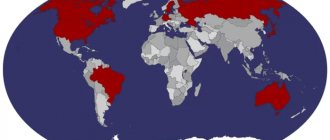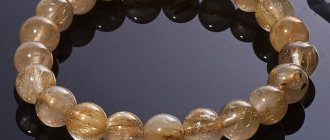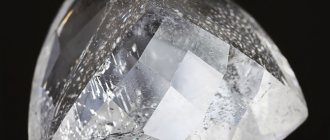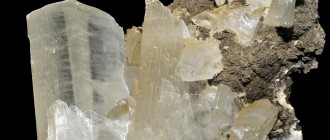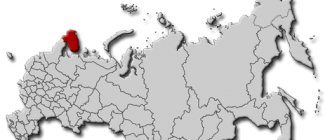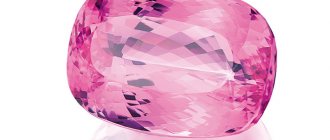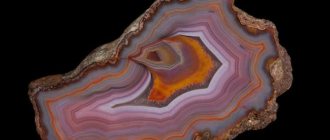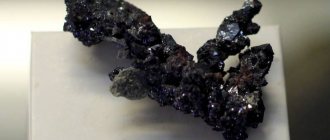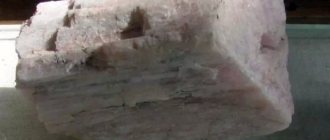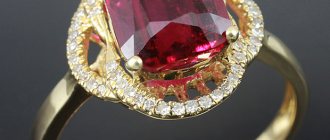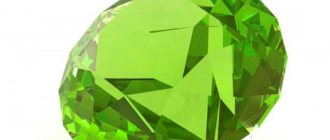Heliotrope is otherwise called bloodstone because of the red flecks on its dark green surface. In some countries, such a stone is called Stephen's stone, or the stone of Christ. Both names are associated with blood - in the first case of the First Martyr Stephen, and in the second - of Christ the Savior.
It is sometimes called "blood jasper". But it has nothing to do with jasper. Heliotropes can have different colors, depending on the inclusions, which create amazing fantastic pictures, which is probably why it got its name.
Heliotropes with yellow inclusions are called plasma. The base color of heliotrope is dark green or blue-green, and the color can be as dark as almost black. The stone has a waxy or resinous luster, and a well-polished one has a vitreous luster.
Heliotrope is one of the opaque varieties of quartz. The stone contains admixtures of chalcedony crystals, iron oxides, celadonite, chlorite...
Red and green shades are created by iron oxides. Its hardness on the Mohs scale is 6.5-7 units. With such hardness, the stone is quite fragile.
Heliotrope deposits
Heliotrope deposits are located in India, Egypt, Russia (Ural Mountains), America, Australia, and there are small deposits in Brazil and China.
History and origin
Heliotrope, which received other names for its specific appearance - “blood stone” and “blood jasper”, is of Asian origin. From Ancient India and Bukhara, it came to Europe about two thousand years ago, where it was revered as a gem associated with Christ and St. Stephen, who suffered execution by stoning.
Bloody Jasper
According to Middle Eastern and European legends, the characteristic red (from scarlet to dark speckled) spots with which this mineral is dotted are drops of the congealed blood of the crucified Christ. Thanks to this, heliotrope became the “trademark” of European mystics and theologians for many centuries.
Pectoral crosses with it are still popular among priests, both Catholic and Orthodox. Various items of church utensils were also often made from it.
Place of Birth
The most ancient heliotrope mines were located in Egypt and Calcutta, but at the moment their reserves are completely depleted.
Modern deposits of this mineral are located in Russia (region of the Ural Mountains). The USA, India and Australia are also active exporters of stones to world markets. Minor deposits of heliotrope rocks can also be found in China, southern Brazil and Central Asia.
Be sure to see: Types, properties and magical powers of agate stone
Physicochemical characteristics
The hardness of the mineral is above average, up to 7 on the Mohs scale. It is a complex mineral, the basis of which is silicon oxide, but inclusions of other minerals, in particular chalcedony, can be found. The closest relative of heliotrope is quartz.
| Formula | SiO2 |
| Color | Dark green, greenish blue with bright red spots |
| Shine | Glass pale shine |
| Transparency | Opaque |
| Hardness | 6,5 — 7 |
| Cleavage | Absent |
| Kink | Uneven |
| Density | Up to 2.58–2.64 g/cm3 |
Heliotrope: description, characteristics
Gems have an oval or octagonal shape. Their peculiarity lies in the presence of an uneven fracture, the presence of pronounced magnetic properties, the ability to pleochroism, as well as iridescence. The stones are resistant to acids, but are susceptible to instability against mechanical influences. This is despite its fairly decent strength.
In terms of physical and chemical parameters, the nugget resembles chrysoprase. Heliotrope stone has sufficient hardness (up to 7 units) according to the Mohs scale. However, it is a fragile and easily deformable mineral. It is refractory and can withstand 2000°C. The gem easily withstands acids. Its chemical formula is silicon dioxide with inclusions of hematite, which forms red spots. Celadonite gives the nugget a green tint.
The nugget often contains quartz or agate, ferrous compounds or chalcedony.
Place of extraction
Currently, heliotrope deposits are being actively developed in the Urals and in the USA - the states of California and Wyoming. There is a small deposit in Bukhara (Uzbekistan). The stone is also mined in Australia, Namibia, Egypt, Armenia, China and India, although the richest and oldest Indian deposit of “blood jasper”, located in Calcutta, has already been exhausted.
Where and how is stone mined?
Nugget refers to volcanic rock that forms in lava voids. When a hot stream slowly flows down the mountain slopes, coming into contact with water, it cools down.
Geologists have discovered deposits of this nugget near ancient and active volcanoes. Until the 17th century, the gem was brought to the territory of the Russian Empire only from the East and was presented as a variety of jasper. For this reason, it was often called bloody jasper, a special stone of the East, or bloodstone.
Place of Birth
Most modern heliotrope deposits are located on the European continent, Central Asia, America, and Australia. Large deposits are found in the following countries:
- Egypt;
- Australia (near Kolkata);
- USA (in California);
- Canada (Wyoming);
- Brazil;
- Russia (only in the Urals).
Relatively recently, the mineral was discovered on the island of Rum, which belongs to Scotland.
Varieties and colors
The term “heliotrope” is more jewelry than chemical. This word can refer to a wide range of stones that are similar in appearance and physical properties, but different in chemical nature. A specific instance of a processed stone may be more related to quartz, or perhaps to chalcedony or jasper, of which it is considered a brother due to its appearance.
The stone looks quite beautiful. It is recognized by its greenish or bluish main color with numerous scarlet, red, burgundy and orange patches, located randomly. They may appear as spots, blotches or streaks. Darker inclusions of hematite are also acceptable.
Incredibly beautiful heliotrope pattern
“Bloody jasper” with yellow splashes is called plasma.
There is no clear classification of heliotropes according to color scheme. Like jasper, with which it is often confused, the gem can play with any colors, but among them there is always green or ultramarine and red. Shades of the main color can be very diverse - from grayish swamp to deep blue.
This is unusual: when looking at some faceted heliotropes, an association arises with photographs of distant galaxies taken through electronic telescopes. Clusters of scarlet, orange and yellow dots on a greenish-blue background turn out to be surprisingly similar in appearance to photographs of stellar nebulae.
This gem is opaque and, after polishing, acquires an almost glassy sheen. In the light, the color may change slightly and “play.”
Heliotrope should not be confused with bloodstone. The latter is distinguished by its rich red color, which can have shades from brown to dark burgundy, the color of dried venous blood. The main external sign of heliotrope is the combination of green or blue with red or yellow.
Green heliotrope with red and yellow splashes
What color is heliotrope
Green - from almost black to light, like young grass, the color is the base. On it, blue, blue, brown areas appear throughout the body of the stone. And red spots, splashes, and ribbons hit the eyes on a calm green background. These inclusions look like blood spattered onto the stone.
If there are no red spots on the stone, only yellow inclusions, then it is called plasma.
The color of each stone is individual; you will not find two identical ones.
Medicinal properties
In lithotherapy, heliotrope is used as a means that can influence blood flow. It is believed that it can improve hematopoiesis, normalize blood pressure and all related processes in the body, primarily digestive. In the Middle Ages, heliotrope - whole or crushed - was often used to stop bleeding from open wounds.
In addition, “bloody jasper” has a beneficial effect on diseased kidneys and can contribute to the painless and most bloodless passage of stones from the bladder. In women, this stone can reduce pain during menstruation, and, in some cases, normalize the menstrual cycle.
Silver pendant with green heliotrope
Silver ring with red heliotrope
The third of the fundamental medicinal properties of heliotrope is its incompatibility with toxins. Heliotrope is credited with the ability to remove toxic substances and toxins from the body - decay products of useful substances processed by the body. Wearing heliotrope increases resistance to infectious diseases, reduces the risk of infection, and gives new strength to the immune system.
The fourth healing property of the stone is its beneficial effect on the psyche. It increases resistance to depression, gives strength and energy, and increases mental performance. "Bloodstone" is a focus of energy. It is recommended to be worn by those who have a need for increased energy consumption - very busy people both physically and mentally (athletes, entrepreneurs, teachers, senior managers) - or vice versa, people with moderate energy consumption, but very little personal energy.
Heliotrope optimizes energy consumption, but if there is no place to realize it, a person may suffer from hyperactivity and excess strength.
Blood Jasper – green heliotrope with red flecks
Magic properties
Due to its origin, this mineral gained fame as one of the most mystical stones, a favorite of medieval magicians and alchemists. The first believed that a ring, bracelet or pendant with it could be an additional source of energy that increases the power of the magician. The latter considered heliotrope a “stone of knowledge”, giving both a desire to comprehend new things and mental abilities that allow them to master a lot of information. Astrologers associate heliotrope with Mars.
Alchemists, scientists, mystics and princes of the Church unanimously agreed that heliotrope, on the one hand, increases intellectual performance, gives strength, determination and activity, but on the other hand, it can turn a person into a fanatic obsessed with one global idea. The "Blood Stone" pushes a person towards a chosen goal with the persistence of a tractor, but this is achieved by "diverting" energy from other areas. The gem takes it from his personal life, from his family, emotional attachments and personal weaknesses.
Heliotrope - blood stone
Initially, it will give determination to a weak person, although it can disrupt, for example, harmony in the family, but it can turn a naturally strong person into a walking battering ram - and at the same time drive him crazy. Wearing heliotrope is strictly unacceptable for those who have not decided on a life goal - there is a risk of finding themselves in a final dead end and at the same time in severe depression. “Bloody Jasper” can have a detrimental meaning for an indecisive person.
People who decide to get jewelry with this stone should remember one thing: the main thing is moderation. If you feel that you are moving towards your goal with leaps and bounds and are about to grab your “bird of happiness,” but at the same time you have a crack in your family or communication with friends, you should take off the amulet.
This is interesting: the magical properties of heliotrope include the materialization of what was said. The magical mineral ensures that everything spoken out loud by its bearer becomes real - from blessing to curse.
What types of heliodor rings are there?
When choosing a ring with heliodor, you need to take into account several nuances so that the jewelry will delight you with its beauty and sophistication for many years.
Frame
As mentioned above, heliodor belongs to the group of precious stones, and therefore the best metal is chosen for it. It can be not only silver and gold, but also noble platinum.
If we talk about gold, then preference is given to pink or white metal, since in classic yellow heliodor may lose its expressiveness, because the mineral itself has a similar golden hue. However, any specimen of heliodor is individual, and therefore the choice of frame is a creative and responsible matter. It all depends on the jeweler - which gold to choose.
Heliodor in platinum looks amazing. Everything is correct: unique and rare gems have the right frame. Naturally, the final cost of the ring increases significantly if this noble metal is present in it.
Silver is the most preferred setting for heliodor. Firstly, it does not particularly affect the final price of the finished product. Secondly, the cold shine of silver merges very harmoniously with a golden gem and perfectly conveys the play of light and the ideal radiance of the stone.
The frame in rings with heliodor can take on different variations. These are soft lines, lace patterns, filigree, and intricate carved weaving - all this makes the decoration special, one might say exceptional.
Cut
The gem is most often cut using faceted types of cutting, in which many small flat edges are applied to the mineral. This allows you not only to emphasize the shade of heliodor and enhance its shine, but also to hide minor defects.
In exceptional cases, the stone is treated with a cabochon or left without treatment at all. Rings with heliodor in its original form are exceptional jewelry, the likes of which you are unlikely to find.
The choice depends on many factors: the size of the mineral, its hardness, purity and transparency, optical properties and, of course, the skill of the cutter. Which cut to choose is a purely individual choice. Smooth edges, smooth transitions, absence of chips and damage are signs of excellent work.
Models
Jewelry store stores are unlikely to be able to boast a varied selection of heliodor rings. Whatever one may say, this is a rather rare gem.
Classic models
Strict, laconic, seasoned. They contain only one stone, and that is heliodor. The design of the ring consists of a thin rim of the frame and one small gem enclosed in the “claws”. The bezel itself is smooth, thin, and does not contain carved patterns or other fancy lines. The exception is the overlay, into which the stone is actually inserted. In rare cases, it can be decorated with laconic filigree to give the ring some solemnity. With all this, classic rings with heliodor do not look pretentious or flashy. You can wear such products in everyday life, as well as to work in the office, a business meeting or negotiations, dinner in a restaurant, a romantic date, a modest evening on the occasion of a family celebration.
Cocktail rings
Large, bright, catchy, spectacular, decorated with a scattering of colored minerals - all this is about cocktail rings. It is simply impossible not to notice such products, but they are created to be noticed. They consist of a wide rim, often decorated with carvings and having different cross-sectional shapes (oval, rectangular or polygonal). Also, in such accessories, both caste and overlay have a special meaning - they give the ring a decorative effect and have different shapes and sizes.
Cocktail rings with heliodor must also include other minerals - this is what makes them special. They look very stylish and bright, with their help you can convey the extraordinary nature and character of your owner, emphasize individuality, and stand out, as they say, in the crowd. Where to wear it? Exclusively special occasions or special occasions. Such products are not suitable for everyday life.
Engagement
Very delicate and graceful, sophisticated and elegant, warm and shining - engagement rings with heliodor become a symbol of a happy family life, warm feelings and inspiration. Perhaps such associations arise due to the shade of the stone, because the golden color conveys the energy of the sun, and newlyweds always want their lives to be filled with warmth and only sunny days.
Compatibility by zodiac signs
Heliotrope stone is not suitable for everyone. Due to the features described above, “blood jasper” is picky about owners. Representatives of not all zodiac signs can wear it constantly and without harm to themselves. Heliotrope only tolerates some, but frankly does not like others.
Below is a horoscope compatibility table.
| Zodiac sign | Compatibility |
| Aries | + |
| Taurus | — |
| Twins | + |
| Cancer | +++ |
| a lion | — |
| Virgo | + |
| Scales | + |
| Scorpion | + |
| Sagittarius | +++ |
| Capricorn | + |
| Aquarius | + |
| Fish | + |
(“+++” – fits perfectly, “+” – can be worn, “-” – is strictly contraindicated)
Compatibility with other stones
In the ancient magic of stones there is a rule that states that each stone has its own “character”. Stones are like medicines: due to their properties, certain stones combine with each other, mutually reinforcing each other, but they can “conflict” with others or remain neutral.
Heliotrope goes well with the following precious and semi-precious stones:
- turquoise,
- agate,
- amethyst,
- beryl,
- emerald,
- cornelian.
Bracelet with heliotrope and carnelian
A neutral combination is the proximity to carnelian or golden topaz.
You should avoid wearing “bloody jasper” at the same time with:
- obsidian,
- onyx,
- malachite,
- sardonyx.
The properties of the stone are poorly revealed in the vicinity of transparent minerals, such as rock crystal, aquamarine or alexandrite (the changeable nature of the latter generally makes it the most difficult of gems). You should not combine it with red ones - the same bloodstone, garnet, ruby and ordinary jasper.
Worn as an amulet
It is not recommended for fickle people to wear heliotrope. Purposeful, hardworking people can wear it to work, before meetings or business trips to quickly build a career. Wearing amulets is indicated for representatives of military professions, since during their service they require concentration and concentration.
When dating or doing creative work, take off the talisman. Because relationships distract from goals, the stone can create barriers to communication.
The mineral will have a beneficial effect on scientists, philosophers, and sages. People involved in intellectual activities should always carry a piece of the breed with them.
Magicians are not recommended to wear jewelry with heliotrope all the time. It is better to put on rings and bracelets immediately before performing the ceremony or reading the spell.
What is made from heliotrope?
This mineral was historically used to create gems, seals, various artistic products from figurines to magical talismans in the form of pyramids, balls and ritual cups. They were often inlaid with metal products, primarily silver, and less often copper, bronze and brass. Gold was rarely used as a setting, since it did not match heliotrope in cost. The price of this gem is too low.
Brass pin with heliotrope
Currently, this ornamental stone is often used to create various souvenirs and amulets. Its physicochemical characteristics ensure ease of processing. “Bloody jasper” is still often framed in silver, made into pendants and earrings, and used as inserts in rings (mostly for men). Sometimes they are used without a frame, for example, in the form of bracelets assembled from processed stone plates.
Bracelet made of processed heliotrope plates
The standard cut is cabochon (for pendants or earrings) or table (for signet rings or bracelets).
Interesting facts about heliotrope
Talismans containing heliotrope can bring good luck to military men, scientists, philosophers and lawyers. They develop thinking and allow you to boldly move towards new achievements. The ancient Egyptian papyri say that there is no more perfect mineral on the planet; its owner gets everything he wants. The stone is capable of destroying walls and opening doors for its owner.
In the Middle Ages, people believed that the nugget attracted rain, was able to stop bleeding, and guaranteed longevity and good health to its owners. It supposedly gives the owner the talent of prophecy, guessing upcoming events. Dante in his “Divine Comedy” mentions heliotrope as a protection against poisons and attributes to it the ability to make the owner invisible.
How to distinguish a fake?
“Bloody jasper” is rarely counterfeited, since its cost is low. But there are synthetic stones on the market, which can be sold as artificial, or maybe under the guise of natural ones.
Natural heliotrope, after cutting and polishing, has a bright glass luster; synthetic stones do not shine like that. To check, you can also use a hardness test: this is a hard mineral that does not remain scratched by a metal needle or knife.
In appearance, it can easily be confused with jasper, which has a wide variety of colors and shades.
Stone care
Craftsmen use heliotrope for ornamental purposes. Faceted, it looks impressive in women's and men's rings, beads, earrings, and bracelets. Despite its sufficient hardness, it is better to handle it carefully: do not drop it, do not scratch it.
Clean the stone and products made with it with a weak solution of cool water and soap. Then rinse under a thin stream and blot with a napkin or delicate cloth.
Jewelers do not recommend polishing with chemicals: this can ruin the surface of the stone and deprive it of its shine. It is also not recommended to wear it during sudden temperature changes.
